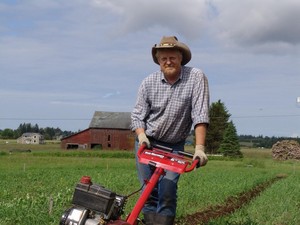06 Aug Thu 2009
What Does Intensive Agriculture Need?
Last week we had blisteringly hot temperatures. Seattle set a record of 103 degrees and it was 94 in Ferndale. Yet, this past week my garden just exploded with produce (and weeds too, of course). I have made a real effort to keep up with my watering this year and to be consistent in my application. This translates into consistent and sufficient soil moisture. I always have good soil fertility, since I work hard at building up my soil. Putting together the three variables of fertility, moisture and heat, it is no wonder I got such rapid growth. Plants are opportunists and if the prepwork has been done for them, they can put on rapid growth. This can translate into huge amounts of green beans, for instance. My CSA customers got $32.60 in produce for a $25 box yesterday, I dropped off a huge box of food at the food bank yesterday, and I will have more food to take to the food bank on Saturday, the next open date.
This brings me to the larger question of what intensive agriculture needs. There are three primary variables: fertility, water and labor. Fertility is important because we are taking so many nutrients out of the soil when we crop intensively, so we must put them back. A more nuanced view is to be proactive, rather than reactive, which is where the idea of building up the soil comes from, rather than just feeding the plants (sustainable vs. industrial). Water is important because intensive agriculture uses a lot of water. This can be taken to extremes, of course, such as the Washington apple industry, which pumps up the apples with so much water they have a huge size, but the same amount of nutrition as a smaller apple. Labor is important, as there is a lot of care involved in intensive agriculture. Industrial agriculture "cheats" by using petroleum laid down by algae 65 million years ago in lieu of human labor. However, this situation is changing back due to peak oil. Soon the era of cheap oil will be over, and thus the era of cheap food. Water is also a problem, so management of ground water will become even more important. I am putting my faith in small farmers like myself, who manage their own wells, rather than bureaucracies like city water departments or irrigation regulatory boards.
Another interesting note is that Egypt had the Nile River to provide both water and fertility. Labor was provided by slaves and they grew enough grain to keep the Roman Empire going. The Aztecs before the Conquest had chinampas (raised beds in lake/marsh areas) to feed a large population. The lakes and marsh bottom muck provided a ready source of both fertility and water. Like the Egyptians, the Aztecs had slaves for the labor element. This should be a warning to us in the peak oil scenarios that are bandied about everywhere these days. Much more human labor is going to be necessary to grow food. Slavery won't work this time around, so unless we get a large segment of the population growing food, we are toast. I project a necessary 25% of the adult population working as full-time farmers.

